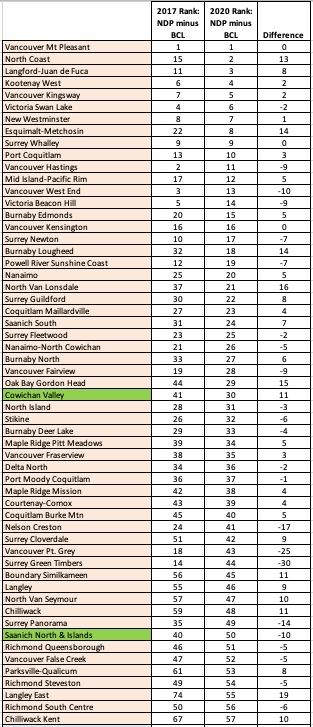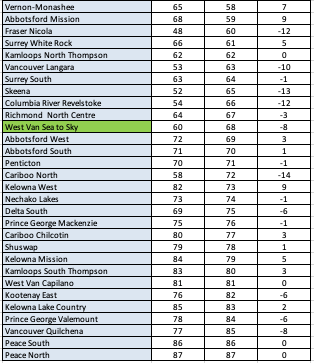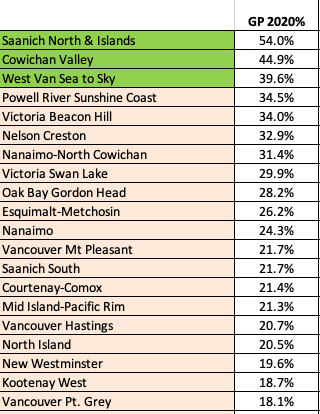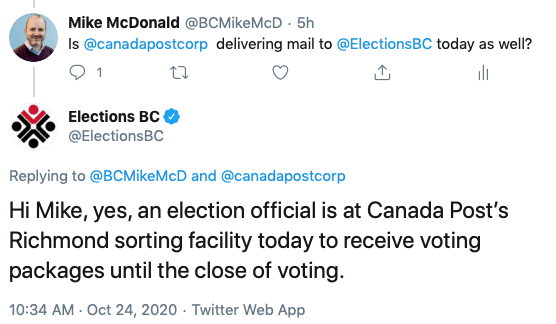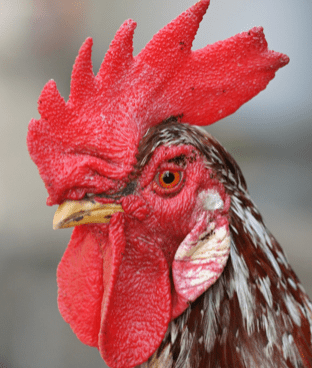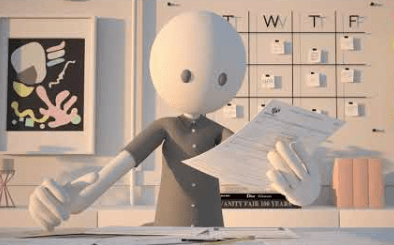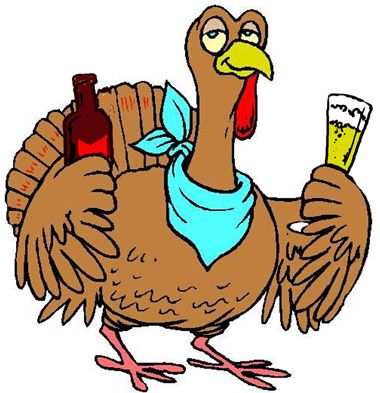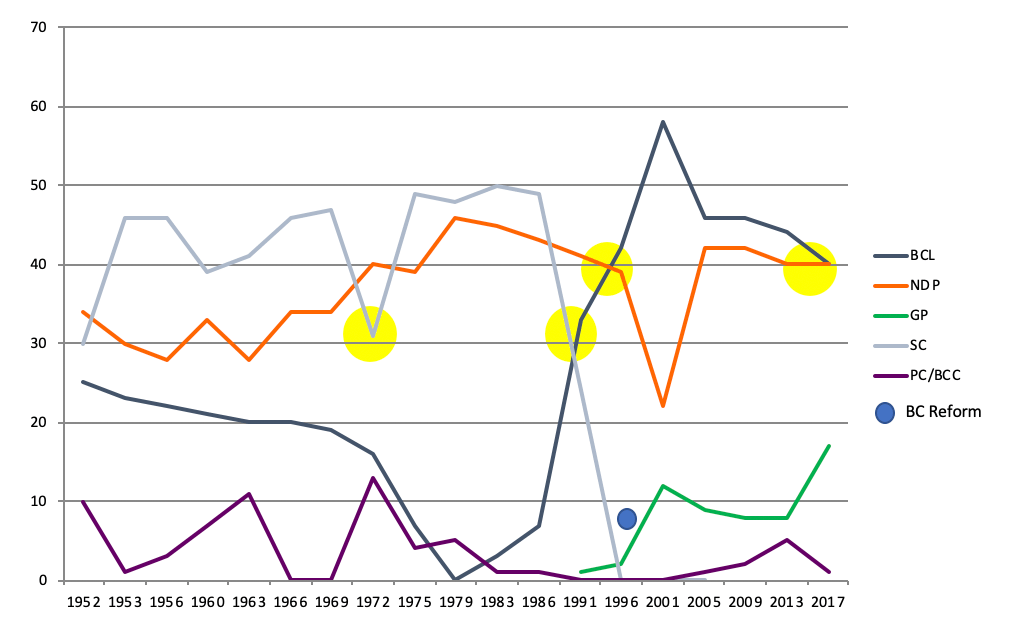Elections BC has been providing daily updates about who has been voting and one thing is clear – it should be a lot easier to get a parking space at the polls on Election Day. More people will have voted early than ever before.
Let’s break it down.
Mail. In 2017, a grand total of 6,517 British Columbians voted by mail (0.3%). This time, there is a more than 100-fold increase, with an estimated 725,000 British Columbians requesting vote-by-mail packages, representing more than one-third of all votes cast in the last election. So far, 304,500 packages (42%) have been received by Elections BC with four days to go. Some who requested packages will decide to vote in person, or won’t vote … hard to say how many, yet.
Advance. In 2017, 617,175 voted in advance polls prior to election night. With the mail-in ballot, it was a question as to how many would show up to advance polls this time. So far, advance voting this time is almost on pace with 472,354 having voted in the first five days, which is about 96% of the 2017 pace of advance voting. There is also an extra day of advance voting this time, so there will actually be more advance votes in 2020 than 2017.
When you add up Mail and Advance, it makes you wonder who’s showing up on Election Day.
Almost two million people voted in 2017 (1,986,374, actually). If 80% of those vote-by-mail packages requested are returned, and advance voting exceeds the level of advance voting in 2017, then I estimate around 1.25 million British Columbians will have voted early. If the same number of people vote this time as 2017, that accounts for about 63% of all ballots cast, leaving only 37% to show up on Election Day and vote. In 2017, two-thirds (66%) of BC voters voted on Election Day.
The number of registered voters in BC has increased by about 7% since 2017 so it is reasonable to expect that more will vote in this election, despite the fact that people say no one is paying attention. (I would say that 725,000 vote-by-mail packages shows that many are paying attention). If the total number of voters increases, then maybe 40% to 50% of all voters will vote on Election Day, but still quite a bit lower than what we are used to.
GOTV. Or ‘Get out the Vote’ for the uninitiated. Campaigns can mark off the 600,000 or so voters that have already voted, but they can’t track who has requested a mail package other than asking people if they have already voted. Therefore, campaigns are chasing voters that may have already voted. Let’s do some rough math. 2 million people vote. 600,000+ vote in advance (30%) – done, cross them off. Around 600,000 vote by mail (30%) and 800,000 vote on E-Day (40%). Campaigns will have a challenge on focusing on the voters that haven’t already voted.
I pity the poor voters who voted by mail but will still be called relentlessly by the local campaign because they are not marked off on a bingo sheet.
Election Night results. What will we know and when will we know it? On Election Night, general voting day ballots and advance poll ballots (most of them) are counted that night. In 2017, an estimated 91% of all ballots were counted and reported on Election Night by bedtime. Even still, it was inconclusive, but that was a bit weird – usually, you know who has won by 9:15pm. This time, they will only count about 70% of the ballots on Election Night by my estimate. That number could be lower if (a) a higher % of people cast their ballots by mail, and (b) there is a lower than expected turnout on Election Day.
Let’s go with 70%. With 30% of the mail ballots outstanding, it will be very hard to call close election races. About 22 of the 87 ridings last time were settled by a margin of 10% or less.
When we will know? As I wrote earlier in the campaign, they don’t even start counting mail ballots until November 6th under normal circumstances. We do not have normal, here. Elections BC has to vet and verify all of the 600,000 plus packages. For example, they have to make sure people don’t vote by mail and vote in person.
They have to count these ballots by hand. They might need to borrow some of those contact tracers.
Once they open the packages, what a delight. Many of the early mail ballots were cast before nominations closed so people could write in their party name or expected candidate. There will be illegible handwriting, spelling errors, and other issues to interpret.
Here’s a brainteaser. In the riding of Richmond-Steveston, there is no Green Party candidate, but the the NDP candidate’s last name is Greene. If someone writes “Green”, what do they mean? I assume Green Party, if there is no ‘e’ on the end, but I can hear the galloping hoofs of lawyer-laden wagons heading to the cannery district already.
The counting of the mail ballots may not start until mid-November or even the third week (one estimate was November 21st). Then they have to count them.
Through all of this time, government is in caretaker mode. This means they can’t do much other than really important stuff that comes up and has to be dealt with. There won’t be a new cabinet until election writs are returned.
The Waiting Game. The worst hour for campaigners is 7:45pm and 8:45pm on election nights when you’ve done pretty much all you can do, but the results haven’t started to flow yet. Imagine having to wait from 7:45pm on Election Night, October 24th, to American Thanksgiving.
For most of the ridings, yeah, they will know. The top of the top NDP ridings and the top of the top BC Liberal ridings will be confirmed that night. You can check out top ridings from last time here.
But where will be the close ones? There will be two variables in play- how close is the race and how many people voted by mail?
Some ridings have seen less than 10% of registered voters request packages while in other ridings it’s over 30%. Province-wide, 21% of registered voters have requested a package.
I don’t know what’s happening on Vancouver Island. As of Monday, almost 2 in 5 registered voters in Oak Bay-Gordon Head and Victoria-Beacon Hill have requested vote-by-mail packages – 38% to be exact. They seem pretty keen to vote over there.
Vote-by-mail has not taken off in many rural ridings. Perhaps voting in person is just the way it oughta be done. Some might say those city slickers can’t be bothered to stretch on their Lululemon pants and take their e-scooter to the poll located in their strata complex, but, by golly, BC’s rural residents will drive three hours through blinding snowstorms to exercise their democratic rights. (I own Lululemon pants, I wouldn’t say that.) Regardless, only 6% of registered voters in North Coast, 8% in Skeena, 9% in Stikine, and 9% in Fraser-Nicola have requested mail packages.
The suspense-filled seat of Courtenay-Comox has had over 12,134 registered voters request packages (26%). That seat was settled by a margin of 189 votes in 2017. Likewise, other 2017 ‘close calls’ have lots of outstanding mail this time: Vancouver-False Creek (13,365), Coquitlam-Burke Mountain (9,572), and Surrey-Panorama (8,130), for example.
Many candidates will simply have to wait it out. They could go to Hawaii for two weeks, quarantine back home for two weeks, and still not know!
More agony. Oh, this is the worst. You know the story about the candidate who is declared elected, but actually lost? (Sorry, Frank). Happens a lot. There are going to be cases of candidates with nice leads on Election Night that see them evaporate when the mail ballots are counted. I don’t know if the mail ballots will be skewed toward the NDP, BC Libs, or Greens relative to Election Night results. Who knows? But what will happen is the poor candidate who has a 127 vote lead has to wait a month to have another 10,000 votes counted. This is, frankly, how you could torture someone as an alternative to waterboarding. A bunch of well-meaning dopes are going to say to them, “Oh, it’s going to be alright. I’m sure you’ll win.” Or gloomy types will wear their anxiety on their sleeves and exist in a waking state of misery. My advice for candidates in a state of suspension – binge watch Netflix and let your team worry about it. Might help.
An election in a pandemic. It’s been a strange one. And it ain’t gonna be over for awhile. You can mail that one in.



